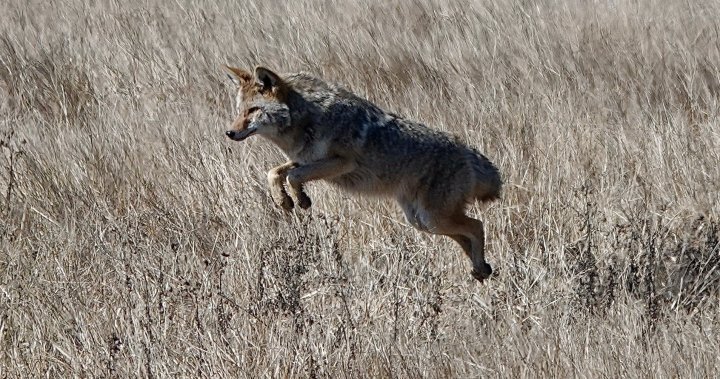In the sleepy community of Nobelton, just north of Toronto, residents are facing an unsettling new reality. A seven-year-old boy’s ordinary afternoon turned terrifying when a coyote attacked him in his family’s backyard last Sunday, leaving the tight-knit community on edge.
The incident occurred around 5:30 p.m. while the child was playing in his yard on Pemberton Road. According to York Regional Police, the coyote seemingly appeared from nowhere, charging at the boy and biting his leg before his parents could intervene. They quickly rushed to his aid, scaring the animal away.
“The child sustained a minor injury and was treated at a local hospital,” Sergeant Clint Whitney told me during a phone interview yesterday. “We’re thankful the injuries weren’t more severe, but this is still deeply concerning for our community.”
What makes this attack particularly troubling is how it challenges the typical understanding of coyote behavior. Wildlife experts have long maintained that coyotes generally avoid human contact, especially in daylight hours.
Ainslie Willock from the Coyote Watch Canada organization explained, “Coyotes are naturally wary of humans. When we see this kind of bold behavior, it often indicates the animals have been intentionally or unintentionally fed by people, which can lead to habituation.”
Local resident Margaret Thornhill, who I spoke with at a hastily organized community meeting Tuesday evening, echoed this concern. “We’ve noticed more coyotes around the neighborhood lately. Some folks leave pet food outside or don’t secure their garbage properly. I wonder if that’s part of the problem.”
York Region has seen a notable increase in coyote sightings this spring. The Ministry of Natural Resources reports a 27% jump in reported coyote interactions compared to the same period last year. Officials attribute this partly to expanding suburban development pushing into formerly wild areas, creating more human-wildlife contact zones.
Township of King Mayor Steve Pellegrini issued a statement urging residents to remain vigilant. “Our community’s safety is paramount. We’re working closely with conservation authorities to address this incident while respecting that we share our environment with wildlife.”
In response to Sunday’s attack, local authorities have implemented several immediate measures. Animal control officers have increased patrols in the Nobleton area, particularly around parks and school zones. Meanwhile, the York Region District School Board sent notices to parents advising extra caution during outdoor activities.
Dr. Melissa Carter, a wildlife biologist I consulted from York University, provided some context. “Spring is a particularly active time for coyotes as they’re often caring for young pups. This can sometimes lead to more defensive behavior, though direct attacks remain extremely rare.”
The statistics back up Dr. Carter’s assessment. According to Ontario’s Ministry of Natural Resources, coyote attacks on humans are exceptionally uncommon, with fewer than five reported incidents annually across the entire province.
For Nobelton residents like Jim Perkins, whose grandchildren visit regularly, the incident has changed how they use their own outdoor spaces. “We’ve lived here for twenty-three years and never worried about letting the kids play in the yard,” Perkins told me, gesturing to his fenced backyard. “Now we’re thinking twice about it, especially around dusk.”
Local authorities have issued practical guidelines for residents. These include not leaving children unattended outdoors in areas where coyotes have been spotted, securing garbage bins, removing potential food sources like fallen fruit, and keeping pets leashed during walks.
If confronted by a coyote, experts recommend making yourself appear larger, making loud noises, and backing away slowly rather than running. “The worst thing you can do is turn your back and run,” Willock emphasized. “Stand your ground, make noise, and the animal will almost always retreat.”
Some community members have called for more drastic measures. At Tuesday’s meeting, several residents pushed for a cull of the local coyote population, but conservation officers cautioned against such approaches.
“Culling often doesn’t solve the problem and can sometimes make it worse by disrupting pack structures,” explained Conservation Officer Derek Saunders. “Our focus needs to be on education, securing attractants, and learning to coexist safely.”
The family of the injured boy has requested privacy while their son recovers, but through a statement released by the hospital, they expressed gratitude for the community’s support and urged neighbors to be cautious.
As spring turns to summer and more families spend time outdoors, this incident serves as a sobering reminder of the delicate balance between suburban living and wildlife. For Nobelton residents, their peaceful community feels slightly less predictable now, as they adapt to sharing space with wild neighbors who occasionally cross invisible boundaries.
Police are asking anyone who spots aggressive wildlife behavior to report it immediately to their non-emergency line or to the Ministry of Natural Resources. Meanwhile, the community waits, watches, and hopes this unfortunate encounter remains an isolated incident.






